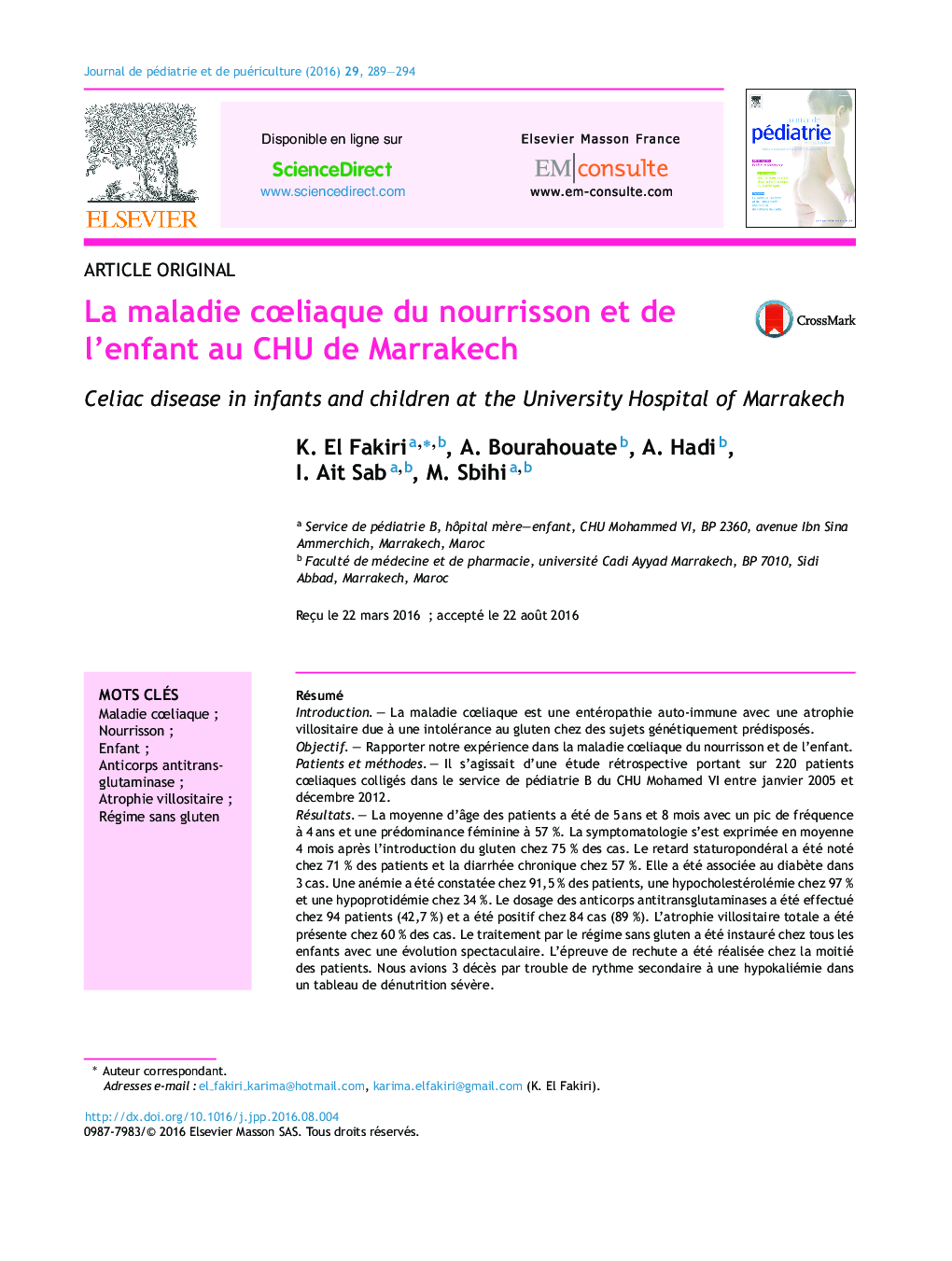| کد مقاله | کد نشریه | سال انتشار | مقاله انگلیسی | نسخه تمام متن |
|---|---|---|---|---|
| 5719873 | 1411280 | 2016 | 6 صفحه PDF | دانلود رایگان |

RésuméIntroductionLa maladie cÅliaque est une entéropathie auto-immune avec une atrophie villositaire due à une intolérance au gluten chez des sujets génétiquement prédisposés.ObjectifRapporter notre expérience dans la maladie cÅliaque du nourrisson et de l'enfant.Patients et méthodesIl s'agissait d'une étude rétrospective portant sur 220 patients cÅliaques colligés dans le service de pédiatrie B du CHU Mohamed VI entre janvier 2005 et décembre 2012.RésultatsLa moyenne d'âge des patients a été de 5 ans et 8 mois avec un pic de fréquence à 4 ans et une prédominance féminine à 57 %. La symptomatologie s'est exprimée en moyenne 4 mois après l'introduction du gluten chez 75 % des cas. Le retard staturopondéral a été noté chez 71 % des patients et la diarrhée chronique chez 57 %. Elle a été associée au diabète dans 3 cas. Une anémie a été constatée chez 91,5 % des patients, une hypocholestérolémie chez 97 % et une hypoprotidémie chez 34 %. Le dosage des anticorps antitransglutaminases a été effectué chez 94 patients (42,7 %) et a été positif chez 84 cas (89 %). L'atrophie villositaire totale a été présente chez 60 % des cas. Le traitement par le régime sans gluten a été instauré chez tous les enfants avec une évolution spectaculaire. L'épreuve de rechute a été réalisée chez la moitié des patients. Nous avions 3 décès par trouble de rythme secondaire à une hypokaliémie dans un tableau de dénutrition sévère.ConclusionCette étude montre la prédominance des formes classiques de la maladie cÅliaque avec une dénutrition sévère secondaire à un retard diagnostique.
SummaryIntroductionCeliac disease is an autoimmune enteropathy with villous atrophy due to intolerance to gluten in genetically predisposed subjects.ObjectiveTo report our experience with celiac disease in infants and children.Patients and methodsThis was a retrospective study of 220 patients with celiac disease collected in the pediatric ward of the University Hospital Mohamed VI between January 2005 and December 2012.ResultsThe average age of patients was 5 years and 8 months with a peak incidence at age 4 and a female 57%. The symptomatology was expressed on average four months after the introduction of gluten in 75% of cases. Growth retardation was noted in 71% of patients and chronic diarrhea in 57%. It has been associated with diabetes in 3 cases. Anemia was observed in 91.5% of patients in 97% hypocholesterolemia hypoprotidemia in 34%. The dosage of antitransglutaminases antibodies was performed in 94 patients (42.7%) and was positive in 84 cases (89%). The total villous atrophy was present in 60% of cases. Treatment with a gluten-free diet was implemented in all children with a spectacular evolution. The relapse test was performed in half of patients. We had 3 deaths disorder secondary to hypokalemia pace in an array of severe malnutrition.ConclusionThis study shows the predominance of traditional forms of celiac disease with severe malnutrition secondary to a delayed diagnosis.
Journal: Journal de Pédiatrie et de Puériculture - Volume 29, Issue 6, December 2016, Pages 289-294